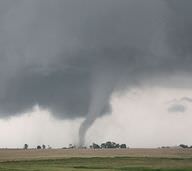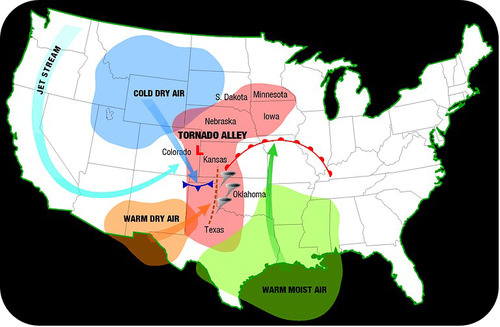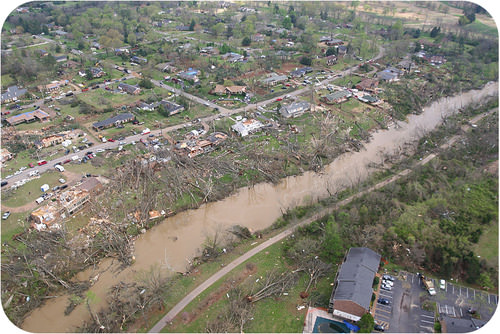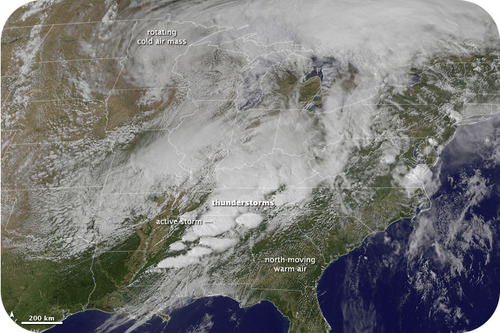11.10: Tornadoes
- Page ID
- 5517
\( \newcommand{\vecs}[1]{\overset { \scriptstyle \rightharpoonup} {\mathbf{#1}} } \)
\( \newcommand{\vecd}[1]{\overset{-\!-\!\rightharpoonup}{\vphantom{a}\smash {#1}}} \)
\( \newcommand{\dsum}{\displaystyle\sum\limits} \)
\( \newcommand{\dint}{\displaystyle\int\limits} \)
\( \newcommand{\dlim}{\displaystyle\lim\limits} \)
\( \newcommand{\id}{\mathrm{id}}\) \( \newcommand{\Span}{\mathrm{span}}\)
( \newcommand{\kernel}{\mathrm{null}\,}\) \( \newcommand{\range}{\mathrm{range}\,}\)
\( \newcommand{\RealPart}{\mathrm{Re}}\) \( \newcommand{\ImaginaryPart}{\mathrm{Im}}\)
\( \newcommand{\Argument}{\mathrm{Arg}}\) \( \newcommand{\norm}[1]{\| #1 \|}\)
\( \newcommand{\inner}[2]{\langle #1, #2 \rangle}\)
\( \newcommand{\Span}{\mathrm{span}}\)
\( \newcommand{\id}{\mathrm{id}}\)
\( \newcommand{\Span}{\mathrm{span}}\)
\( \newcommand{\kernel}{\mathrm{null}\,}\)
\( \newcommand{\range}{\mathrm{range}\,}\)
\( \newcommand{\RealPart}{\mathrm{Re}}\)
\( \newcommand{\ImaginaryPart}{\mathrm{Im}}\)
\( \newcommand{\Argument}{\mathrm{Arg}}\)
\( \newcommand{\norm}[1]{\| #1 \|}\)
\( \newcommand{\inner}[2]{\langle #1, #2 \rangle}\)
\( \newcommand{\Span}{\mathrm{span}}\) \( \newcommand{\AA}{\unicode[.8,0]{x212B}}\)
\( \newcommand{\vectorA}[1]{\vec{#1}} % arrow\)
\( \newcommand{\vectorAt}[1]{\vec{\text{#1}}} % arrow\)
\( \newcommand{\vectorB}[1]{\overset { \scriptstyle \rightharpoonup} {\mathbf{#1}} } \)
\( \newcommand{\vectorC}[1]{\textbf{#1}} \)
\( \newcommand{\vectorD}[1]{\overrightarrow{#1}} \)
\( \newcommand{\vectorDt}[1]{\overrightarrow{\text{#1}}} \)
\( \newcommand{\vectE}[1]{\overset{-\!-\!\rightharpoonup}{\vphantom{a}\smash{\mathbf {#1}}}} \)
\( \newcommand{\vecs}[1]{\overset { \scriptstyle \rightharpoonup} {\mathbf{#1}} } \)
\( \newcommand{\vecd}[1]{\overset{-\!-\!\rightharpoonup}{\vphantom{a}\smash {#1}}} \)
\(\newcommand{\avec}{\mathbf a}\) \(\newcommand{\bvec}{\mathbf b}\) \(\newcommand{\cvec}{\mathbf c}\) \(\newcommand{\dvec}{\mathbf d}\) \(\newcommand{\dtil}{\widetilde{\mathbf d}}\) \(\newcommand{\evec}{\mathbf e}\) \(\newcommand{\fvec}{\mathbf f}\) \(\newcommand{\nvec}{\mathbf n}\) \(\newcommand{\pvec}{\mathbf p}\) \(\newcommand{\qvec}{\mathbf q}\) \(\newcommand{\svec}{\mathbf s}\) \(\newcommand{\tvec}{\mathbf t}\) \(\newcommand{\uvec}{\mathbf u}\) \(\newcommand{\vvec}{\mathbf v}\) \(\newcommand{\wvec}{\mathbf w}\) \(\newcommand{\xvec}{\mathbf x}\) \(\newcommand{\yvec}{\mathbf y}\) \(\newcommand{\zvec}{\mathbf z}\) \(\newcommand{\rvec}{\mathbf r}\) \(\newcommand{\mvec}{\mathbf m}\) \(\newcommand{\zerovec}{\mathbf 0}\) \(\newcommand{\onevec}{\mathbf 1}\) \(\newcommand{\real}{\mathbb R}\) \(\newcommand{\twovec}[2]{\left[\begin{array}{r}#1 \\ #2 \end{array}\right]}\) \(\newcommand{\ctwovec}[2]{\left[\begin{array}{c}#1 \\ #2 \end{array}\right]}\) \(\newcommand{\threevec}[3]{\left[\begin{array}{r}#1 \\ #2 \\ #3 \end{array}\right]}\) \(\newcommand{\cthreevec}[3]{\left[\begin{array}{c}#1 \\ #2 \\ #3 \end{array}\right]}\) \(\newcommand{\fourvec}[4]{\left[\begin{array}{r}#1 \\ #2 \\ #3 \\ #4 \end{array}\right]}\) \(\newcommand{\cfourvec}[4]{\left[\begin{array}{c}#1 \\ #2 \\ #3 \\ #4 \end{array}\right]}\) \(\newcommand{\fivevec}[5]{\left[\begin{array}{r}#1 \\ #2 \\ #3 \\ #4 \\ #5 \\ \end{array}\right]}\) \(\newcommand{\cfivevec}[5]{\left[\begin{array}{c}#1 \\ #2 \\ #3 \\ #4 \\ #5 \\ \end{array}\right]}\) \(\newcommand{\mattwo}[4]{\left[\begin{array}{rr}#1 \amp #2 \\ #3 \amp #4 \\ \end{array}\right]}\) \(\newcommand{\laspan}[1]{\text{Span}\{#1\}}\) \(\newcommand{\bcal}{\cal B}\) \(\newcommand{\ccal}{\cal C}\) \(\newcommand{\scal}{\cal S}\) \(\newcommand{\wcal}{\cal W}\) \(\newcommand{\ecal}{\cal E}\) \(\newcommand{\coords}[2]{\left\{#1\right\}_{#2}}\) \(\newcommand{\gray}[1]{\color{gray}{#1}}\) \(\newcommand{\lgray}[1]{\color{lightgray}{#1}}\) \(\newcommand{\rank}{\operatorname{rank}}\) \(\newcommand{\row}{\text{Row}}\) \(\newcommand{\col}{\text{Col}}\) \(\renewcommand{\row}{\text{Row}}\) \(\newcommand{\nul}{\text{Nul}}\) \(\newcommand{\var}{\text{Var}}\) \(\newcommand{\corr}{\text{corr}}\) \(\newcommand{\len}[1]{\left|#1\right|}\) \(\newcommand{\bbar}{\overline{\bvec}}\) \(\newcommand{\bhat}{\widehat{\bvec}}\) \(\newcommand{\bperp}{\bvec^\perp}\) \(\newcommand{\xhat}{\widehat{\xvec}}\) \(\newcommand{\vhat}{\widehat{\vvec}}\) \(\newcommand{\uhat}{\widehat{\uvec}}\) \(\newcommand{\what}{\widehat{\wvec}}\) \(\newcommand{\Sighat}{\widehat{\Sigma}}\) \(\newcommand{\lt}{<}\) \(\newcommand{\gt}{>}\) \(\newcommand{\amp}{&}\) \(\definecolor{fillinmathshade}{gray}{0.9}\)Where do you go to see a tornado? Tornado Alley!
Tornadoes are deadly serious. The deadliest in recent years killed 158 people in Joplin, Missouri in 2011. More than 550 people died in the United States from tornadoes that year. The deadliest tornado on record killed 629 people in 1926. This "tri-state" tornado raced across Missouri, Illinois, and Indiana.
Tornadoes
Severe thunderstorms have a lot of energy and strong winds. This allows them to produce tornadoes. A tornado (Figure below) is a funnel-shaped cloud of strong whirling winds. The funnel moves along the ground, destroying everything in its path. As it moves, it loses energy. Before this happens, it may have gone up to 25 kilometers (16 miles). Fortunately, tornadoes are narrow. They may be only 150 meters (500 feet) wide. Tornadoes are also called twisters.
Tornadoes are small but mighty storms.
Classifying Tornadoes
The winds of a tornado can reach very high speeds. The faster the winds blow, the greater the damage they cause. Wind speed and damage are used to classify tornadoes (Table below).
| F-Scale Rating | Wind Speed (kilometers per hour) | Wind Speed (miles per hour) | Damage |
|---|---|---|---|
| F0 | 64-116 | 40-72 | Light - tree branches fall and chimneys may collapse |
| F1 | 117-180 | 73-112 | Moderate - mobile homes, autos pushed aside |
| F2 | 181-253 | 113-157 | Considerable - roofs torn off houses, large trees uprooted |
| F3 | 254-332 | 158-206 | Severe - houses torn apart, trees uprooted, cars lifted |
| F4 | 333-419 | 207-260 | Devastating - houses leveled, cars thrown |
| F5 | 420-512 | 261-318 | Incredible - structures fly, cars become missiles |
| F6 | >512 | >318 | Maximum tornado wind speed |
Tornado Alley
Look at the map below (Figure below). It shows where the greatest number of tornadoes occur in the U.S. Tornadoes can happen almost anywhere in the U.S., but only this area is called “Tornado Alley.” Why do so many tornadoes occur here? This is where warm air masses from the south run into cold air masses from the north.
Tornadoes are most common in the central part of the U.S.
Damage
A tornado strikes only a small area, but it can still destroy everything in its path. Most injuries and deaths from tornadoes are caused by flying debris (Figure below). In the United States, an average of 90 people are killed by tornadoes each year. The most violent two percent of tornadoes account for 70% of the deaths by tornadoes.
Tornado damage that occurred in the City of Murfreesboro, TN when it was struck by an F-4 tornado.
April 2011
Late April 2011 saw the deadliest set of tornadoes in more than 25 years. There were more than 150 tornadoes reported throughout one day! Severe thunderstorms came about when two very different air masses met. A warm moist air mass blew north from the Atlantic Ocean and Gulf of Mexico (mT). It rammed into a cold polar air mass (cP) that the was sitting over the region. In addition, the jet stream was blowing strongly in from the west (Figure below).
April 27-28, 2011. The cold air mass is shown by the mostly continuous clouds. The warm air mass is indicated by small low clouds. Thunderstorms are indicated by bright white patches.
Everyone in the region was told that tornadoes were possible. But it's impossible to know exactly where and when a tornado will touch down. The path it will take is unknown, because tornado movement is not very predictable.
Summary
- A tornado is a whirling funnel of air extending down from a cumulonimbus cloud.
- The Fujita scale measures tornado intensity based on wind speed and damage.
- Tornadoes can only be predicted over a wide region.
Review
- What causes the tornadoes of Tornado Alley?
- Draw a diagram showing why tornadoes strike the middle of the U.S.
- What circumstances led to all the tornadoes in April 2011?






